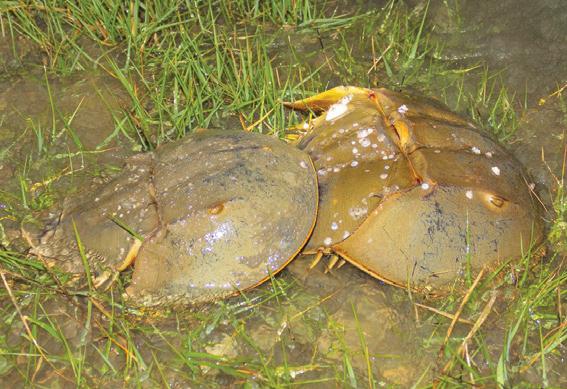
3 minute read
Salt Marsh & Horseshoe Crabs
By Erin Weeks Media Coordinator SCDNR Marine Resources Division
It’s one of the great natural spectacles of the Atlantic coast – every spring, masses of horseshoe crabs come ashore and crowd sandy beaches to mate and lay eggs.
Advertisement
Such beaches have long been considered the best and possibly only environment where horseshoe crab eggs can successfully hatch and grow. But South Carolina Department of Natural Resources biologists recently confirmed that horseshoe crab eggs and hatchlings can also survive in a surprisingly different environment – the salt marsh. Their findings were recently published in the peerreviewed journal The Biological Bulletin.
“We’ve known for a long time that horseshoe crabs spawn in the salt marsh, but we thought those eggs didn’t survive the lowoxygen environment of pluff mud.” said assistant scientist Dr. Michael Kendrick, who leads horseshoe crab research at SCDNR. “The adaptability of this species to successfully reproduce in a wide range of habitat types really highlights one of the reasons why this group of animals has existed on the planet for more than 480 million years.”
The American horseshoe crab is an ancient marine invertebrate recognized by its pointed tail and domed ‘head,’ which protects six pairs of walking and feeding feet. Although they spend much of their lives offshore feeding on small clams and worms in the seafloor, they’re not uncommon on South Carolina and Georgia beaches – particularly when they come ashore under new and full moons to mate and lay eggs during the spring.
Horseshoe crabs play a critical role in the coastal ecosystem and human health: their eggs are an important food sources for tens of thousands of shorebirds making long migrations, and a compound in their blood is collected and used to detect contamination in vaccines and medical devices.
While horseshoe crab numbers have steeply declined in places such as New York, the most recent study by the Atlantic States Marine Fisheries Commission (to which SCDNR biologists contribute) found the Southeast’s horseshoe crab population to be in “good” condition. In an article published in 2019 in the peer-reviewed Journal of Shellfish Research, based on sampling conducted in 2014, SCDNR geneticists found little evidence of inbreeding, suggesting that the state’s horseshoe crabs are relatively healthy.
As coastal South Carolina continues to grow and change, however, biologists will continue monitoring where crabs are spawning, how many there are and the state of their genetic health.
That’s why SCDNR biologists sought to determine whether the horseshoe crabs observed spawning in the salt marsh were contributing viable eggs to the population. These flat, tidally flooded wetlands between land and sea define much of the South Carolina and Georgia coast, but their importance to horseshoe crabs is not well understood.
In June 2019, staff collected samples of horseshoe crab eggs at 28 locations in marshes and 32 locations on beaches and assessed them for successful development. From each of these samples, they looked at a minimum of 50 eggs, embryos and trilobites (young horseshoe crabs) under a microscope and classified the developmental stage of each. Using statistical computing software, they then analyzed for habitat differences among each of seven distinct developmental stages.
They found healthy horseshoe crab eggs, embryos and trilobites in both marsh and beach locations, demonstrating that eggs laid in the salt marsh could in fact successfully hatch and develop despite apparent sub-optimal conditions.
However, they also found significant differences in the two habitat types. While the prevalence of early and middle developmental stages was similar across habitats, beach sites were more likely to have advanced-stage trilobites. Marshes also had a higher number of discolored eggs, which are likely less viable. Because the surveys represent just a snapshot in time, the authors are conducting additional research this year to help determine whether these distinctions reflect differences in spawning timing
Horseshoe crabs are occassionally seen mating and laying eggs in the marsh, but the environment was previously assumed to be unsuitable for egg development. Photo by Kaitlyn Hackathorn, SCDNR
(horseshoe crabs could lay on beaches at different times than in marshes) or differences in the rates of development.
Regardless, Dr. Kendrick says the findings have changed the way his team thinks about the importance of the salt marsh to the animals they study.
“[Salt] marsh habitats in this region could represent a significant, but previously underappreciated, source of horseshoe crab embryos that may contribute substantially to the adult population,” the authors wrote.
It’s horseshoe crab season right now, and you can help SCDNR biologists better understand this fascinating animal! If you see horseshoe crabs spawning on the coast, please report your sightings with photos to surveymonkey.com/r/HorseshoeCrab.










